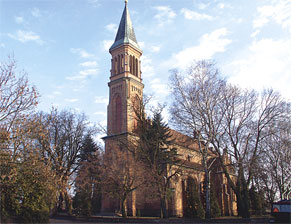 |
| Home |
Polish Index |
Back | Next |
 |
Lithuanian RemnantsThe Maruszewski family lived in present day Mazovia, a province in central Poland that includes Warsaw. They lived for centuries near the banks of Sona River in a small village named Marusy. Traces of Lithuanian culture remain after an ancient invasion of Lithuanian tribes conquered the area, The name of the Sona River, for instance, is the Lithuanian name for Sonja. The village of Sonsk is derived from that name. Marusy still belongs to the Sonsk Parish, which is seated at the church in a village by the same name just west of Marusy. The Sona river flowing past it oin the north and west south toward the Wykra. Sonsk ParishThe church and parish of Sonsk was founded in 1519 by Jan of Chroscic, from an office in Plock, the first provost of the Sonsk Church. The rear portion of the church was made of stone and it was concecrates to Saints Wita and Modesta. The church has four alters in four chapels and a chapel; to St. Pawel. In 1871, the church was completely restored and the surroundings walled with stone. |
 |
|
The parish functioned as a civil records office since the time of Napoleon, who dictated just how the records needed to record each baptism, marriage and death. Before Napoleonic records, the records were simple Latin records many of which did not record the surnames of peasants. It is oftern difficult to distinguish the families of, say, several Jans. Napoleon greatly lessoned the abiguity found in the Latin version of vital records. The Russians later varied what Napoleon did, allowing the records to be also recorded in Polish, but after 1863 they required records to be transcribed into Russian. MarusyMarusy is the Maruszewski family nest. It is not an accident that the name of the village is the root for the surname. This family had noble roots and early origins, perhaps, from Lithuania. The town consisted of a village and the Maruszewski manor. Centuries ago the Maruszewskis hired and/or owned landed peasants to work the farm. By the time of the partitions, one can see from the records that the Maruszewski family was no longer rich, probably did not have serfs, and had sub-divided their property so many times through inheritance, that little was left.This problem was typical in Poland. Perhaps the following figures help to illustrate that: In 1827 there were 42 homes and 236 inhabitants. By the late 19th century the village had 35 homes, 379 people with 636 morgs belonging to the petty nobility. There were seven fewer houses but forty-three more people to feed and shelter over the course of only about 70 years. This might be why, Albina's family had moved from Marusy south to Gasocin to establish a new home. |
| Home |
Polish Index |
Back | Next |
© Copyright: This information is presented only for genealogical purposes and may not be copied in any form without written permission by the author. |
How to contact me: Andrew Jendrzejewski Ajend2@me.com |